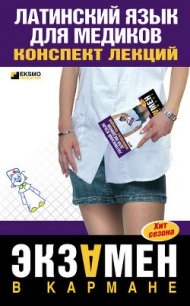Английский язык для медиков - Беликова Елена (читать книги онлайн бесплатно без сокращение бесплатно .TXT) 📗
15. Neck. Cervical vertebrae, cartilages, triangels
Cervical vertebrae: There are seven cervical vertebrae of which the first two are atypical. All cervical vertebrae have the foramina transversaria which produce a canal that transmits the vertbral artery and vein.
Atlas: This is the first cervical vertebra (C1). It has no body and leaves a space to accommodate the dens of the second cervical vertebra. Axis: This is the second cervical vertebra (C2). It has odontoid process, which articulates with the atlas as a pivot joint. Hyoid bone is a small U—shaped bone, which is suspended by muscles and ligaments at the level of vertebra C3.
Laryngeal prominence is formed by the lamina of the thyroid cartilage.
Cricoid cartilage. The arch of the cricoid is palpable below the thyroid cartilage and superior to the first tracheal ring (vertebral level C6). Triangles of the neck: The neck is divided into a posterior and an arterior triangle by the sternocleidomastoid muscle. These triangles are subdivided by smaller muscles into six smaller triangles. Posterior triangle is bound by the sternocleidomastoid, the clavicle, and the trapezius. Occipital triangle is located above the inferior belly of the omohyoid muscle. Its contents include the following: CN XI Cutaneous branches of the cervical plexus are the lesser occipital, great auricular, transverse cervical, and supaclavicular nerves.
Subclavian (omoclavicular, supraclavicular) triangle is located below the inferior belly of the omohyoid. Its contents include the following: Brachial plexus supraclavicu—lar portion The branches include the dorsal scapular, long thoracic, subclavius, and suprascapular nerves.
The third part of the subclavian artery enters the subclavian triangle.
The subclavian vein passes superficial to scalenus anterior muscle. It receives the external jugular vein.
Anterior triangle is bound by the sternocleidomastoid muse the midline of the neck, and the inferior border of the body of the mandible. Muscular triangle is bound by the sternocleidomastoid muscle, the superior belly of the omohyoid muscle, and the midline of the neck. Carotid (vascular) triangle is bound by the sternocleidomastoid muscle, the superior belly of the omohyoid muscle and the posterior belly of the digastric muscle. The carotid triangle contains the following: Internal jugular vein; Common carotid artery, bifurcates and form the internal and external carotid arteries. The external carotid artery has six branches (i. e., the superior thyroid; the ascending pharyngeal, the lingual, the facial, the occipital, and the posterior auricular arteries). Vagus nerve; hypoglossal nerve; internal and external laryngeal branches of the superior laryngeal branch of the vagus nerve. Digastric (sub—mandibular) triangle is bound by the anterior and posterior bellies of the digastric muscle and the inferi or border of the body of the mandible. It contains the submandibu—lar salivary gland. Submental triangle is bound by the anterior belly of the digastric muscle, the hyoid bone, and the midline of the neck. It contains the submental lymph nodes.
16. Neck. Root, fascies of the neck
Root of neck: This area communicates with the superior medi astinum through the thoracic inlet. Structures of the region include the following: subclavian artery and vein. The subclavian artery passes poste rior to the scalenus anterior muscle, and the vein passes ante rior to it. Branches of the artery include: vertebral artery; thyrocervical trunk, which gives rise to the inferior thyroid, the transverse cervical, and the suprascapular arteries; Internal thoracic artery.
Phrenic nerve is a branch of the cervical plexus, which arises from C3, C4, and C5. It is the sole motor nerve to the diaphragm. It crosses the anterior scalene muscle from lateral to medial to enter the thoracic inlet.
Recurrent laryngeal nerve is a branch of the vagus nerve. This mixed nerve conveys sensory information from the laryngeal; mucosa below the level of the vocal folds and provides motor innervation to all the intrinsic muscles of the larynx except the cricothyroid muscle.
Thoracic duct terminates at the junction of the left subcla—vian and the left internal jugular veins. On the right side of the body, the right lymphatic duct terminates in a similar fashion.
Fascias of the neck: Superficial investing fascia encloses the platysma, a muscle of facial expression, which has migrated to the neck.
Deep investing fascia surrounds the trapezius and ster—noclei – domastoid muscles.
Retropharyngeal (visceral) fascia surrounds the pharynx.
Prevertebral fascia invests the prevertebral muscles of the nee (i. e., longus colli, longus capitis). This layer gives rise to a derivative known as the alar fascia.
The major muscle groups and their innervations. A simple method of organizing the muscles of the neck is based on two basic principles: (1) The muscles may be arranged in group according to their functions; and (2) all muscles in a group share common innervation with one exception in each group.
Group 1: Muscles of the tongue. All intrinsic muscles plus all but one of the extrinsic muscles (i. e., those containing the suffix, glossus) of the tongue are supplied by CN XII. The one exception is palatoglossus, which is supplied by CN X.
Group 2: Muscles of the larynx. All but one of the intrinsic muscles of the larynx are supplied by the recurrent la—ryngeal branch of the vagus nerve. The sole exception is the cricothyroid muscle, which is supplied by the external laryngeal branch of the vagus.
Group 3: Muscles of the pharynx. All but one of the longitudinal and circular muscles of the pharynx are supplied by CNs X and XI (cranial portion). The sole exception is the stylopharyngeus muscle, which is supplied by CN IX.
Group 4: Muscles of the soft palate. All but one of the muscles of the palate are supplied by CNs X and XI (cranial portion). The sole exception is the tensor veli palatini, which is supplied CN V3.
Group 5: Infrahyoid muscles. All but one of the infrahyo—id muscles are supplied by the ansa cervicalis of the cervical olexus (C1, C2, and C3). The exception is the thy—rohyoid, which is supplied by a branch of C1. (This branch of C1 also supplies the geniohyoid muscle).
New words
neck – шея
cervical – цервикальный
vertebrae – позвоночник
cricoid cartilage – перстневидный хрящ гортани
scapulae – лопатка
scalene – лестничная мышца
brachial plexus – плечевое сплетение
vagus nerve – блуждающий нерв
hypoglossal nerve – подъязычный нерв
laryngeal branches – гортанные ветви
17. Thoracic wall
There are 12 thoracic vertebrae. Each rib articulates with the body of the numerically corresponding vertebra and the one below it. Sternum: the manubrium articulates with the clavicle and the first rib. It meets the body of the sternum at the sternal angel an important clinical landmark.
The body articulates directly with ribs 2–7; it articulates interiorly with the xiphoid process.
Ribs and costal cartilages: there are 12 pairs of ribs, which are attached posteriorly to thoracic vertebrae.
Ribs 1–7 attach directly to the sternum by costal cartilages.
Ribs 8—10 attach to the costal cartilage of the rib above. Ribs 11 and 12 have no anterior attachments. The costal groove is located along the inferior border of each rib and provides protection for the intercostal nerve artery, and vein.
There are 11 pairs of external intercostal muscles.
These muscles fill the intercostal spaces from the tubercles of ribs posteriorly to the costochondral junctions anteriorly. There are 11 pairs of internal intercostal muscles.




